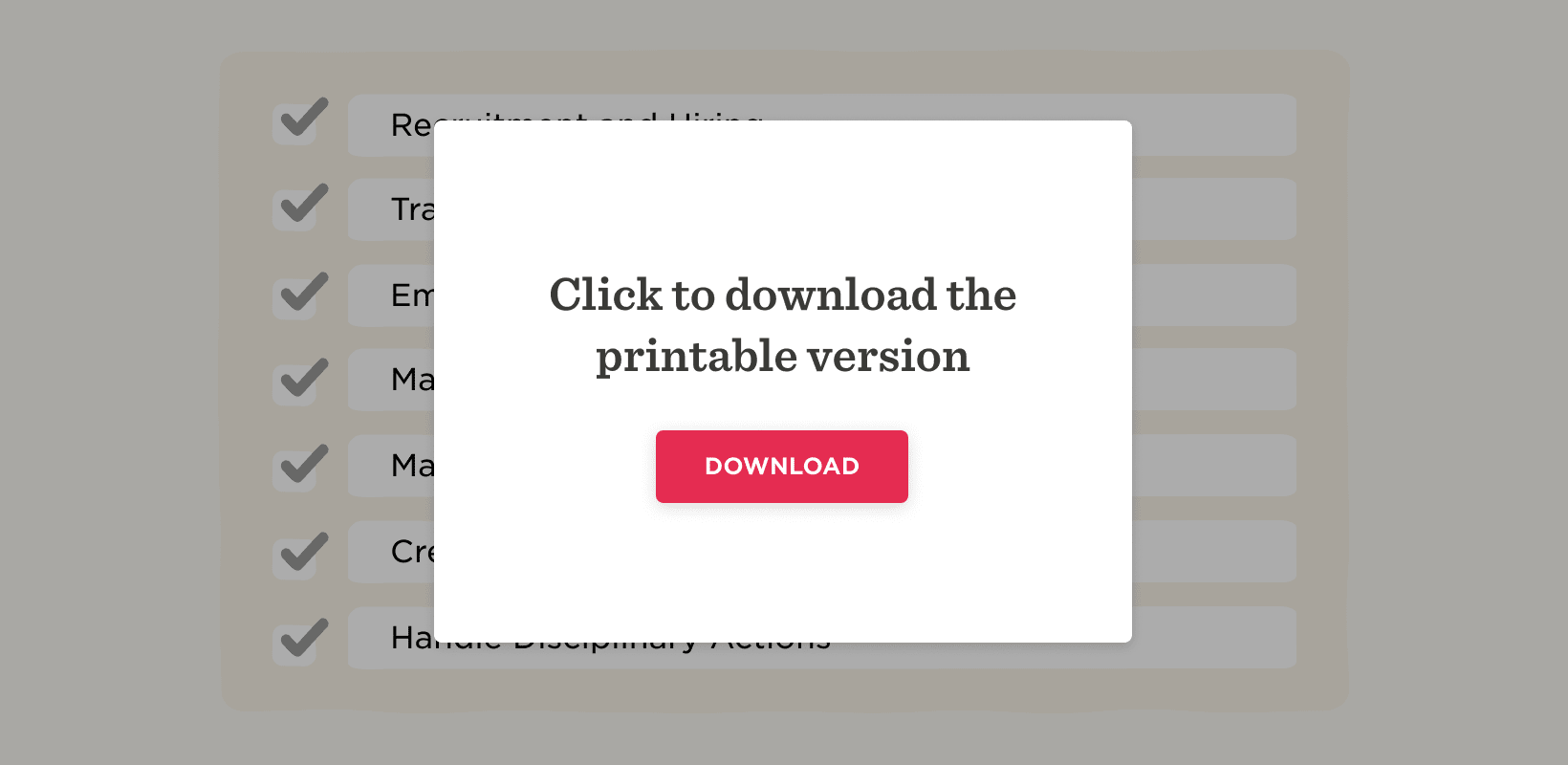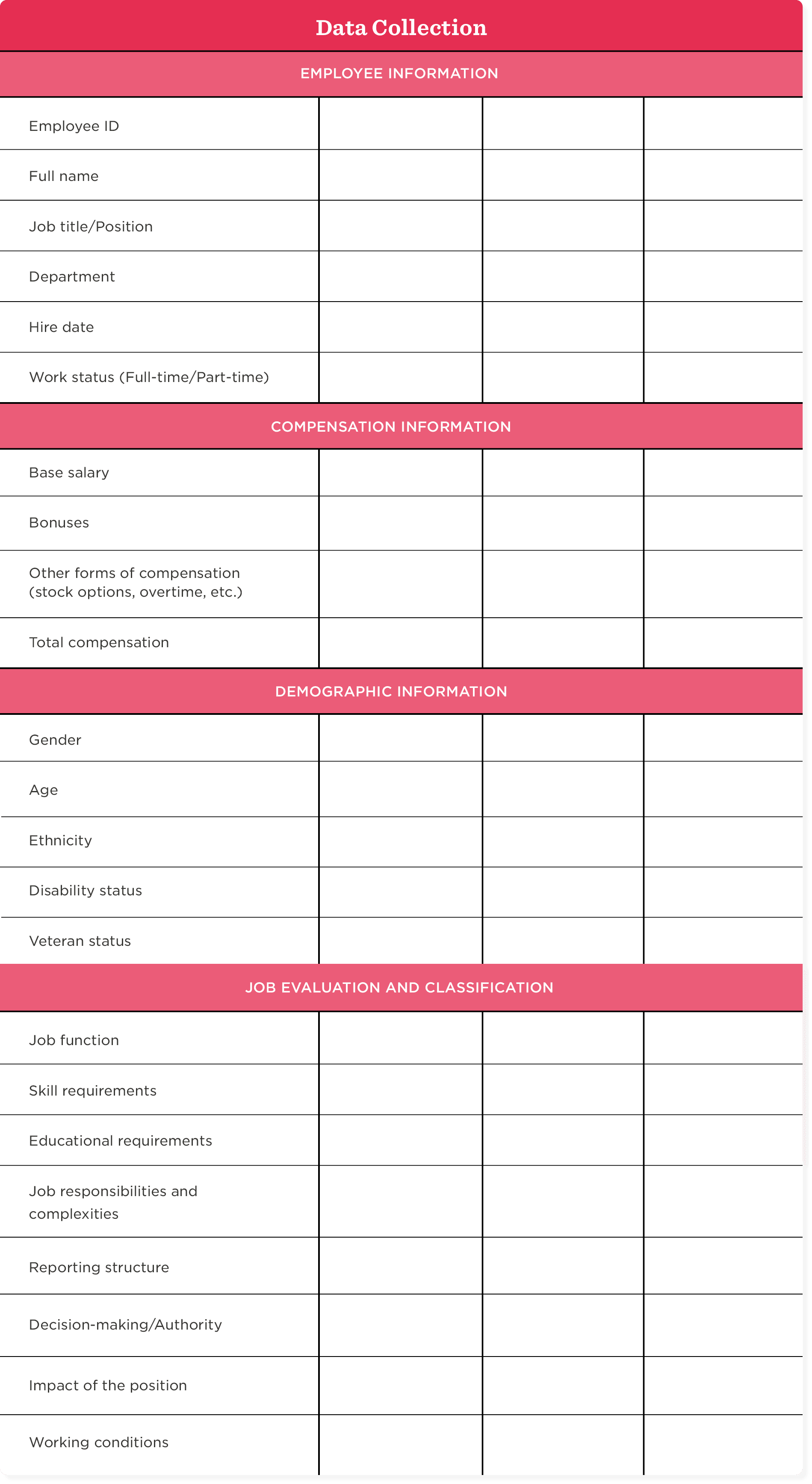In the ever-evolving workforce landscape, businesses are constantly challenged to adapt to changes in circumstance, including shifting societal norms and expectations. One such area is pay equity.
Striving for equitable compensation isn’t just the morally right way to conduct your business: It allows you to place your company as a thoughtful, progressive place to work. On top of that, potential talent and stakeholders view companies championing pay parity as more attractive.
By conducting a pay equity audit, businesses can address and rectify any gender or diversity gaps in compensation, thereby enhancing their commitment to fairness and pay transparency.
In this guide, we’ll provide you with an easy-to-use, free printable template and outline a step-by-step process for conducting your own comprehensive pay equity audit.
With these tools, you can easily navigate the pay equity audit process and ensure your business is fair and transparent for all.
<<Download and print the pay equity template to run a fair and equitable process>>
Understanding pay equity audits
Pay equity audits are systematic examinations that help organizations identify and address discrepancies in their compensation structures.
Audits are not merely about flagging discrepancies—although that is important—they’re about putting measures in place to ensure equitable pay is a long-term goal.
One thing that’s important to understand is that pay equity doesn’t simply equate to equal pay. It’s a broader concept that seeks to ensure that companies pay people who perform similar work equitably, regardless of their gender, race, or identity.
By proactively conducting pay equity audits, companies can avoid potential legal consequences while fostering a more inclusive and fairer workplace.
The importance of pay equity
The fight for pay equity is part of a larger global struggle for equal rights and social justice. Achieving pay equity means moving beyond simply complying with the law to actively promote justice and fairness within the organization.
Pay equity leads to various benefits at both individual and organizational levels.
For your team members, it means fair recognition for their work, which can lead to increased motivation, job satisfaction, and productivity.
For organizations, it means attracting and retaining top talent, improving their reputation, and fostering an inclusive workplace culture.
Moreover, the rise of social media and increased transparency means that pay equity issues are now more visible and scrutinized than ever before. Organizations that address any pay equity issues can improve their reputation and gain trust among team members and the public.
Why use a pay equity audit template?
In the pursuit of pay equity, having a standardized process can significantly enhance the efficiency and effectiveness of your efforts.
A pay equity audit template provides a structured approach to data collection, analysis, and the development of remedial strategies.
It’s a tool that can help you methodically address complex issues surrounding pay disparities, enabling your organization to make informed decisions based on factual data rather than assumptions or perceptions.

The 7 steps to conducting a pay equity audit
When carrying out your pay equity audit, there are several steps you need to take to make sure it’s as thorough and detailed as possible.
- Prepare your audit team. Assemble a dedicated team to spearhead your audit. This team should ideally be made up of representatives from your HR department, legal team, and senior management.
- Identify comparable jobs. Establish criteria for what constitutes comparable work across your organization’s various job titles or functions.
- Collect data. Put together a comprehensive list of your team members, their job titles, pay rates, and other relevant information such as their education, experience, and performance metrics.
- Analyze your data. Using the data collected, identify any disparities or discrepancies in pay among your team members who are performing similar work.
- Interpret your results. Now that you’ve analyzed your data, you’ll be in a position to start recognizing any patterns or systematic disparities in how you compensate your team members. This is also the stage where you can investigate the reasons behind specific disparities.
- Develop remedial strategies. Once you have identified and gained an understanding of the disparities in your organization, you can formulate strategies on how you can start to correct them.
- Implement changes and monitor progress. The final step is to fully implement your devised strategies to correct any gender pay gaps or any other form of discriminatory pay gaps and then monitor the results over a set period of time. If these problems persist, you may need to consider tweaking your strategies until you start seeing better results.
Our pay equity audit template



Remember. This is just a template and will need to be adapted to fit the needs of your organization. It’s also important to account for any legal and ethical considerations when carrying out these types of audits, especially when handling sensitive personal data.
<<Download and print the pay equity template to run a fair and equitable process>>
Recommended For Further Reading
Best practices and considerations for a pay equity audit and analysis
A pay equity audit, though incredibly beneficial, can be a delicate process, and it, therefore, needs careful handling and tactful communication.
Here are some best practices and considerations to keep in mind while conducting your pay equity audit:
- Confidentiality. Confidentiality is paramount during an audit. This process requires collecting sensitive data, including personal information and compensation details. Ensure that only the dedicated audit team has access to this data and that it is stored securely to maintain complete privacy and trust. In addition, when presenting the results, it is crucial to use aggregated data that does not reveal the specific information of individual team members.
- Continual audits. Achieving pay equity isn’t a one-time activity but an ongoing commitment. With changes in personnel, company structure, and market forces, pay disparities may end up creeping back into your organization over time. Regular audits, at least annually, are essential to maintaining fair and equitable pay. They enable your company to catch and address any disparities as quickly as possible while also demonstrating your unwavering dedication to pay equity.
- Transparent communication. Transparency is a cornerstone of trust. However, it doesn’t mean revealing individual compensation details to everyone. Rather, it’s about maintaining open communication about the processes and policies that determine pay and sharing the reasons and objectives behind the pay equity audit. Once you complete the audit, it’s important to communicate its outcomes and any actions the company plans to take in response to the findings. By doing so, you can demonstrate that your organization is serious about pay equity and fosters a culture of trust and inclusivity.
- Inclusive analysis. Ensure your audit considers all the factors contributing to pay decisions. This should include the role or job title and factors such as tenure, performance, education, and location. An inclusive analysis helps ensure that your audit captures the complete picture and that its findings are as accurate as possible.
- Action plan. Once the audit is complete and you’ve identified disparities, developing a strategic action plan to rectify these is crucial. This may involve adjusting the salaries of certain team members, revising the compensation management policies, or offering training and development opportunities to underpaid team members. The goal is to identify the problem and actively work towards a solution.
- Consulting experts. Pay equity audits can be complex and require a nuanced understanding of compensation data and legal guidelines. Depending on your organization’s size and resources, engaging with external consultants or legal advisors specializing in compensation and pay equity might be a good idea.
You can demonstrate a commitment to fair and equal compensation by conducting effective pay equity audits, bolstering your reputation as a progressive employer.
A fair and equal workplace
Pay equity audits, while complicated, are essential for promoting fairness and equality within your workplace.
They require meticulous data collection, careful analysis, and dedicated action to address any disparities you discover. However, with the right pay equity audit tools, such as our template, and commitment from all levels of your organization, conducting a pay equity audit can be rewarding and transformative.
